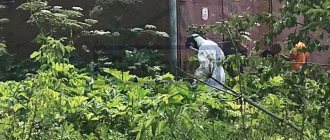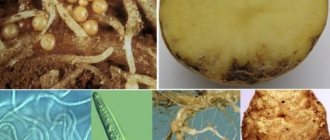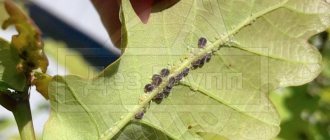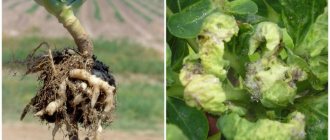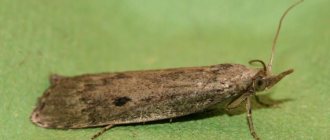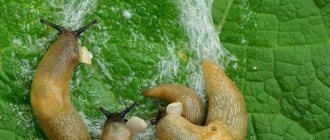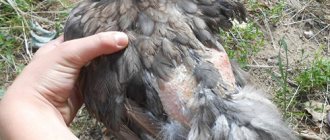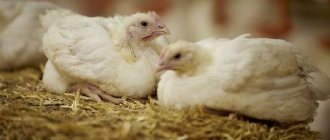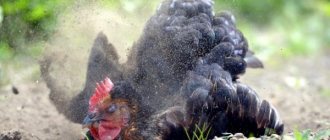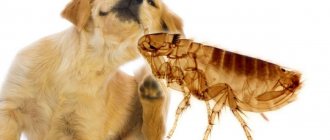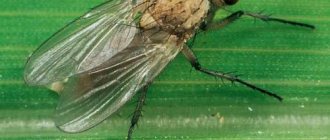Not only adults and children love raspberries. Various insects are also not averse to feasting on it. The greatest danger among them is the raspberry beetle. In everyday life it is often called raspberry. Pest settlements in the bushes can lead to the most unpleasant consequences. The plant begins to wither, the beetle larvae make the berries unsuitable for consumption and sale, and significantly reduce the yield. Preventive measures and the right strategy for exterminating raspberry beetles will help get rid of them once and for all.
Description of the raspberry beetle
Before taking action, you need to find out more about what kind of insect this is and what negative impact it has on the raspberry bush.
Appearance
This beetle belongs to the order Coleoptera and the family Malinniki . It lives mainly in areas where raspberries and blackberries grow. Outwardly, it resembles a glitter. The insect has a long oval body from 3.5 to 4.5 mm.
This beetle is painted dark gray or brown and covered with numerous fibers. The abdomen has a more saturated reddish tint. The antennae are club-shaped, yellow or white, and the claws are serrated.
Beetle Reproduction
The mating season for this insect occurs in mid-May. The raspberry beetle reproduces by laying tiny light-colored eggs about 1 mm in diameter. The masonry is made into the raspberry flower itself.
Next, yellow, worm-like larvae emerge from the eggs with three pairs of legs and a fuzzy body. There are black spots on each segment of the body. The larva grows up to 6.5 mm in length.
Adults and young individuals overwinter in the upper layer of soil under bushes at a depth of about 20 cm. In spring, when the air temperature begins to remain above +13°C, insects come to the surface. Typically this period occurs at the end of April - beginning of May.
Damage to raspberries
The beetles feed on young foliage and raspberry flowers: the pests bite into the buds and eat out the nectaries. In appearance, the flower remains undamaged, but subsequently does not set an ovary. The larvae make their way inside the berry and eat the receptacle and drupes. Because of this, ripe raspberries begin to dry at the base of the stalk, become deformed, lose their taste and later fall off.
Disease Prevention
You will not have to deal with the described pests if timely prevention of raspberries is carried out. The optimal season for preventive treatment is mid-April. The buds on the bush are still closed, but the circulation of juices is already proceeding in spring mode.
Many gardeners recommend dousing raspberries with boiling water after winter; this kills the larvae of many insects and repels them. Irrigation and watering of the soil near the trunks is carried out with copper sulfate (3% solution) or Bordeaux mixture. Boric acid and potassium permanganate have an antibacterial effect and cause the death of pest larvae.
In addition to using solutions, dry and lifeless raspberry branches should be cut off immediately, as pests like to settle in them. Onions or garlic are planted near raspberries. These crops repel insects because they have a pungent odor.
If you constantly monitor the development of the bush and pay attention to it from time to time, the raspberries will never become infected with pests. Even if infection occurs, it will be eradicated at a very early stage, so there will be no harm to the berries or the bush itself
In growing raspberries, it is of great importance to carry out pest prevention and monitor the condition of the crop.
Beetle control methods
The fight against this pest combines a number of agrotechnical techniques, as well as preventive and therapeutic treatment of plantings.
Agrotechnical techniques
The fight against raspberry beetles must begin with simple agricultural techniques:
- Perform deep digging of the soil in autumn and spring. Thanks to this, the number of pupae that overwinter in the soil is significantly reduced. At the same time, add wood ash and tobacco dust to the soil.
- In the warm season, sprinkle the soil around the bush with mulch to prevent insects from leaving the soil. Crushed peat, sawdust or humus are suitable for this.
- Before flowering, spread a tarp under the plants and shake off insects from the branches, then destroy them. Carry out the procedure early in the morning, when the beetle is inactive.
- To plant raspberry bushes, choose a place as far as possible from apple and pear trees - raspberry beetles use these plants as additional food.
- Before flowering, the bushes can be covered with gauze or agrofibre - this will protect the plant from the harmful effects of the pest.
- Regularly inspect the plantings, manually collect damaged fruits, and then burn them.
- In early spring, carry out preventive treatment of the soil around the bushes with Bordeaux mixture at a concentration of 2%.
Ground beetles are considered the natural enemies of the raspberry beetle. These are fairly large beetles, usually black in color, and belong to one of the most common families of these insects. To attract ground beetles closer to raspberries, you need to plant garlic or onions next to them.
Biological products
To destroy this pest, the drug “Guapsin” is widely used, which has a very good result in the fight against raspberry beetles - up to 94%.
2% Bitoxibacillin has the same properties. Treatment with biological products should be carried out twice: before the appearance of buds and before the flowers bloom.
Chemicals
Treatment with insecticidal agents is carried out twice a year: before and after flowering.
The following drugs are used for this:
- “Iskra” is a tablet product that is dissolved in water at the rate of 1 tablet per 10 liters of liquid.
- "Karbofos" - it is used when a large number of beetles are detected. 90 g of the active substance must be diluted in 10 liters of water.
- “Kinmiks” or “Confidor” are emulsions prepared according to the included instructions. To treat 1 bush you need 1.5 liters of working solution.
- “Fufanon” at a concentration of 0.1% is recommended for high degrees of damage in the bud formation phase.
Traditional methods
In addition to chemicals, there are also a number of folk ways to combat this pest:
- Potassium permanganate solution . An aqueous solution is prepared from this substance: 1 g of active substance is needed per 20 liters of liquid. After the snow has melted, the resulting product is used to treat the soil under the bushes.
- Mustard solution . The plant is treated with it before flowering. To do this, mix 100 g of mustard in a small amount of hot water until it reaches a creamy consistency. Then dilute the resulting mass with another 10 liters of water.
- Tansy infusion . Infuse 700 g of the plant in 1 bucket of water for 24 hours, then bring to a boil and cook for about 30 minutes. Cool the infusion, strain and add another 10 liters of water.
- Tobacco infusion . To obtain it, pour 1 cup of dry substance with 10 cups of water, then leave on fire for 2 hours. Before applying to the soil, dilute with water at a rate of 1:3.
- Soda solution . Before the ovaries appear, the bushes need to be sprayed with this substance. For 10 liters of water you will need 1 tbsp. spoon of powder.
Processing raspberries as a means of preventing worms in berries
The worm spoils ripe raspberries. To protect raspberry bushes from worms, it is necessary to carry out preventive measures. A way to treat raspberries in the spring against worms:
- In early spring, the bushes are watered with hot water (80 degrees). It is recommended to douse bushes and soil;
- In the fall, the area with raspberries must be dug up, the remaining weeds must be removed, and the soil must be mulched. Humus, peat, sawdust, and compost are used as mulching materials. Worms living on the soil surface cannot get out from under the mulch layer;
- During the flowering period, worms can be collected by hand. The surest way to quickly remove worms from raspberries and clean all the bushes is to spread the film on the ground and shake the raspberry bushes. Carefully collect and burn fallen worms;
- A popular way to treat raspberries for worms in the berries: the bushes are sprayed with a soda solution (10 g soda plus 5 liters of water) or mustard infusion.
Pests can cause serious damage to a gardener. They can damage raspberry bushes and ruin the harvest
Therefore, it is important to carefully inspect the bushes in spring and summer and promptly destroy them when insects appear. Knowing how to get rid of worms in raspberries, weevils, flies, and bedbugs, you can grow a large harvest of aromatic, delicious berries
Raspberry beetle. Mission: recognize and destroy
Oh, how sweet, aromatic raspberries beckon! We still need to find those indifferent to this summer delicacy! And there certainly isn’t a single summer resident who doesn’t have such an unpretentious and productive berry plant growing on his plot.
Raspberry is a delicious berry
We are all looking forward to midsummer so we can quickly taste the amazing taste of this berry. But when the long-awaited moment of harvest arrives, some people receive raspberries with a surprise - they find disgusting yellowish worms in them. Instead of pleasure - disappointment, and then bewilderment and irritation! How to call this nimble enemy, who managed to “bite” the berries, and most importantly, how to rid the plantings of his invasion?
Raspberry beetle larva
Description of the pest
The culprit of crop damage is the raspberry beetle, also called the common raspberry beetle (Byturus tomentosus). Despite its small size (4-6 mm), this grayish-red bug causes significant damage to raspberries. It produces numerous and unusually voracious offspring, which by the time of harvest manage to spoil a significant part of the berries, and with mass reproduction, completely deprive the gardener of the delicacy.
Raspberry beetle
Raspberries begin to play pranks already at the end of April or beginning of May when the soil warms up to +10. +12°C. First, they fill their bellies with young leaves and nectar from early flowering plants, giving preference to weeds. However, beetles do not disdain cultivated plants: insects damage the leaves, buds and flowers of apple trees, pears, plums, cherries, currants, etc.
For dessert, the pest leaves his favorite raspberries. The beetles move to the bushes and feed on young leaves, and then begin oviposition. The female places one egg at a time in the buds or young raspberry ovary, and manages to lay up to 50 eggs in a short time. They soon hatch into larvae about 6 mm long, which immediately begin to eat the pulp of the berries.
The raspberry beetle larvae have worked. Photo from the site vechorka.ru
The worms continue to feast for 1.5 months, so gardeners often take them by surprise already at harvest. You can find berries without larvae, but with signs of their recent activity - such fruits usually rot at the stalk and turn out to be small and ugly.
Having eaten their fill, the larvae leave the spoiled fruits and plunge into the soil near the bushes to a depth of 5-20 cm, where they pupate and “grow up” - at the end of summer or September they turn into new beetles. Those, in turn, remain to overwinter in the soil, and next spring they give birth to the next offspring of pests.
Life cycle
Raspberry beetle.
Initially, forest raspberries become the source of infection. Bugs appear where plantings are overly thickened. In the absence of raspberries, the bugs eat bird cherry, blueberries and cloudberries.
In spring, at temperatures of +12 degrees and above, pests become more active. They eat greens to restore their strength. They actively mate and lay eggs in the buds. When the ovaries appear, the caterpillars are also selected.
For a month and a half, they eat berries, actively working with their jaws. After harvesting, the caterpillars choose a place in the raspberry roots and spend the winter there. They pupate at the beginning of the warm season.
Control measures
Knowing the development cycle of this insect, it is easy to prevent its subsequent reproduction and protect the raspberry crop from damage. In this matter, timely agrotechnical techniques, delicate folk remedies, lethal chemicals and gentle biological products come to the rescue.
Agrotechnical techniques
Before you go on the warpath with the raspberry beetle, take a look at your raspberry bed - is it too thick? Since autumn and spring digging of soil between the rows of the berry garden, as well as regular loosening of the soil around the bushes can significantly reduce the number of pupated larvae and young beetles, take care of the convenience of carrying out such procedures and first thin out the raspberry plantings.
Thinning bushes will make it easier to care for plantings
Shortly before flowering, when the beetles begin to move en masse onto the raspberry bushes, spread a tarp, film or any other material under them, and then shake the branches vigorously. Collect and destroy pests that have lost their balance and fallen down. Some summer residents who have free time lovingly wrap raspberry bushes with light non-woven material shortly before the buds begin to form and remove the cover after the inflorescences bloom. Such a mechanical barrier significantly reduces the number of “new settlers” and protects the future harvest from damage.
Regularly remove weeds near raspberries
During the season, regularly remove weeds near the raspberry plantation and directly under the bushes - the beetles, after emerging from hibernation, first colonize the weeds. If there are no such “enticements” near the raspberry rows, the beetles will move to other places.
Folk remedies
According to reviews from experienced gardeners, the raspberry beetle loses its position under the influence of ordinary mustard powder. Based on this traditional kitchen product, you need to prepare a solution of 10 liters of water and 100 g of powder and generously moisten the raspberry bushes with it during the budding period and immediately after the petals fall from the flowers.
How to save your crop from the raspberry beetle
Not only adults and children love raspberries. Various insects are also not averse to feasting on it. The greatest danger among them is the raspberry beetle. In everyday life it is often called raspberry. Pest settlements in the bushes can lead to the most unpleasant consequences. The plant begins to wither, the beetle larvae make the berries unsuitable for consumption and sale, and significantly reduce the yield. Preventive measures and the right strategy for exterminating raspberry beetles will help get rid of them once and for all.
Spider mites on raspberries
Spider mites cause great harm to raspberry bushes. This pest multiplies quickly, especially in dry times. Raspberry plantings that are too thick are at greatest risk. The fact that plants are infected with spider mites is eloquently indicated by yellowed and quickly falling leaves. It is in them that ticks spend the winter, and in the spring they continue their “activities”.
To get rid of spider mites, you need to:
- Collect and burn foliage affected by the pest.
- Immediately after harvesting, treat the bushes with Acrex.
- In early spring, spray raspberry bushes with urea.
For those who have a high mite infestation of raspberries and who are concerned about the question of how to spray raspberries against pests, we can recommend the effective drug Fufanon. As practice shows, in most cases, only one treatment with this product is required to get rid of pests.
Detailed description and photo of the pest
The raspberry beetle is a typical representative of the raspberry family from the order Coleoptera. In accordance with its name, it chooses plantings of garden, ornamental raspberries and blackberries as its habitat. Sources of additional nutrition can be currants, gooseberries, cherries, thorn bushes, pears, and rowan.
Appearance
How to recognize a pest:
- the raspberry beetle is characterized by an oblong oval body, its length ranges from 3.5 to 4.5 mm;
- the color is predominantly dark gray, with red-colored individuals being less common;
- the body is densely covered with hairs of the same color;
- along the edges of the pronotum and abdomen the color is more saturated, most often it is reddish;
- brown or yellow club-shaped antennae and serrated claws.
The eggs are tiny in size, not exceeding 1 mm, capsule-shaped, yellow or white.
The worm-like larva of the raspberry beetle boasts 3 pairs of movable legs, a yellowish color and sparse fibers on the body. Each segment is decorated with dark spots. The maximum length of a young individual is 6.5 mm.
On a note! A characteristic feature of the larvae is the presence of two hook-shaped spines on the last segment of the body, which are curved upward.
Features of life
Adults and larvae spend the winter in the surface layers of the soil at a depth of 5-20 cm under or near raspberry bushes. With the arrival of spring, when the earth warms up to +13°C, they leave their shelters and climb to the surface. Typically, the time of awakening from hibernation occurs in the last ten days of April or the first days of May.
Hungry raspberry beetles begin to actively replenish their supply of nutrients. They feed on weeds and flower nectar. Direct colonization of berry bushes occurs before flowering. Insects eat young leaves, and when flowers and buds appear, they focus all their attention on them. The beetles bite into the buds and eat away the nectaries, leaving the sepals intact.
Interesting! Raspberries have extraordinary flying abilities. They can travel considerable distances in search of flowering plants.
Harm from raspberry beetles
After wintering, insects use quince, pear, and apple trees as a source of additional food and eat away the internal parts of flowers. On gooseberry and currant bushes, the buds are damaged. Their presence can be determined by small holes with jagged edges.
On berry bushes, adult raspberries damage buds, flowers, and young foliage, which leads to a decrease in yield. The larvae eat up the drupes, the berries begin to dry out at the base of the stalk, in which the pest's passages are clearly visible.
Affected fruits become deformed, lose their presentation, taste and quality. Most often, they can no longer be eaten.
Berries that are not too damaged can be saved by immersing them in lightly salted water for 30-40 minutes. During this time, the larvae will float to the surface, and the fruits can be used to make confitures and jam.
Stem gall midge
Gall midge is the formation of new growths on young shoots. The growth is parasitized by small organisms that poison the shoot and lead to its death. The larvae themselves are almost invisible to the naked eye, their size is only 1-2 millimeters. In spring, the growth cracks, and small mosquitoes form from it, which continue laying eggs on neighboring branches. Insects tolerate winter well and do not die out. The defeat of gall midges in the initial stages may be invisible, but with the onset of August the growths already become visible.
The only sure way to combat the parasite is to trim the visible growth. The entire growth is cut off from the shoot, and the cut site is filled with garden varnish. Instead of pitch, you can use hydrogen peroxide, clay, or oil paint. Even the affected shoot, from which the growth has been cut, continues to grow and bear fruit. Stem gall midge is not considered a dangerous disease; it is easily cured and does not cause consequences.
Pest control methods
The fight against raspberry beetles involves a complex of agrotechnical measures and preventive measures. In cases of severe infestation, heavy artillery is used - insecticides. If the work is carried out in a timely manner, the prognosis is positive and the bushes can be cleared of pest invasion.
Detailed instructions on how to deal with raspberry beetles:
- In early spring and late autumn it is necessary to dig the soil deeply. In this way it is possible to significantly reduce the number of pupae. In spring, a thick layer of mulching is recommended to prevent insects from leaving the soil after wintering.
- Before flowering, during the period of migration of raspberry beetles, you should lay a tarpaulin or any other cloth on the bushes, and gently shake the plants. Destroy fallen insects. The procedure is recommended to be carried out in the morning, when the air temperature does not exceed 15°C. Under such conditions, the beetles are apathetic and inactive.
- Remove excess branches in a timely manner, cut off dried tops and branches, and thin out. This will ensure better air circulation.
- Do not plant raspberry trees near apple and pear plantations, which pests use as additional food, and also regularly remove weeds from the area.
- Before flowering, you can cover the bushes with gauze or agrofibre. The process is very tedious and time-consuming, but it will avoid a massive invasion of raspberry beetles.
- It is recommended to periodically feed the seedlings with ash and organic fertilizers.
- To disrupt the food connection between plants and raspberry beetles, remontant raspberries are planted, which bear fruit twice a year.
Application of insecticides
The use of chemicals is advisable when 3-4 larvae or adults are found on the bush. In addition, timely spraying will prevent the appearance of pests such as weevils and leaf rollers.
Important! To obtain the desired effect, irrigation with insecticidal preparations is carried out twice during the budding period: before flowering and after. It is strictly forbidden to spray the bushes during the flowering period.
Preparations for the destruction of raspberry beetles:
- Iskra product in tablets. One tablet dissolves in 10 liters of water.
- If the number of beetles is small, the plants are treated with a solution of Karbofos, at the rate of 90 g per 10 liters of water.
- Emulsions “Kinmiks”, “Confidor”. The working solution is prepared according to the instructions. 15 liters is enough to process 10 young raspberry bushes.
- Biological products “Guapsin” and “Bitoxibacillin” are distinguished by their high destructive ability, destroying up to 90% of larvae. And also, thanks to the content of bacteria, they accelerate the dissolution of soil fractions, thereby providing better nutrition for plants.
The list of products is supplemented by Fufanon, Inta-vir, Actellik, Fosbecid. It is important not to forget that when working with chemicals you should wear a respirator, protective suit, and gloves.
